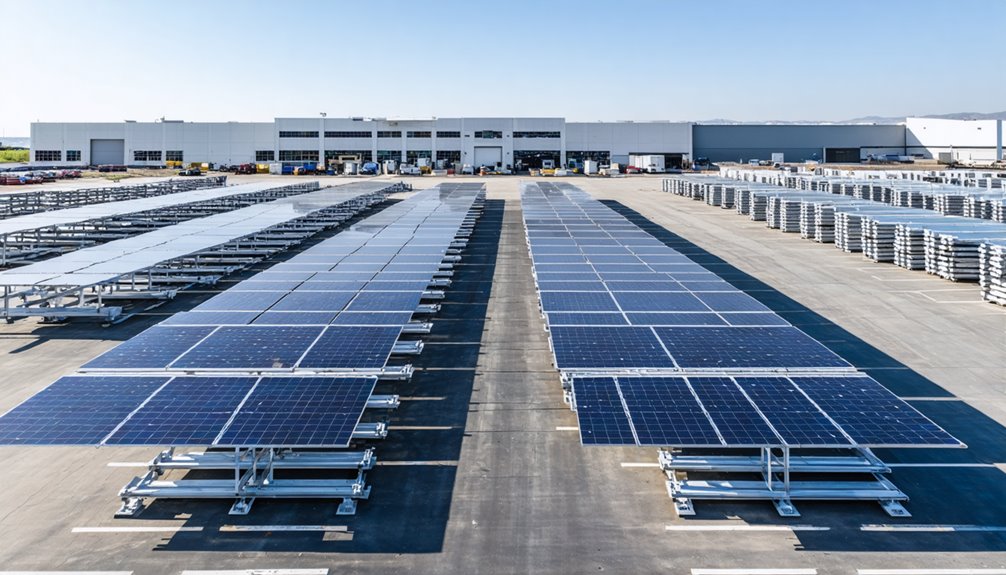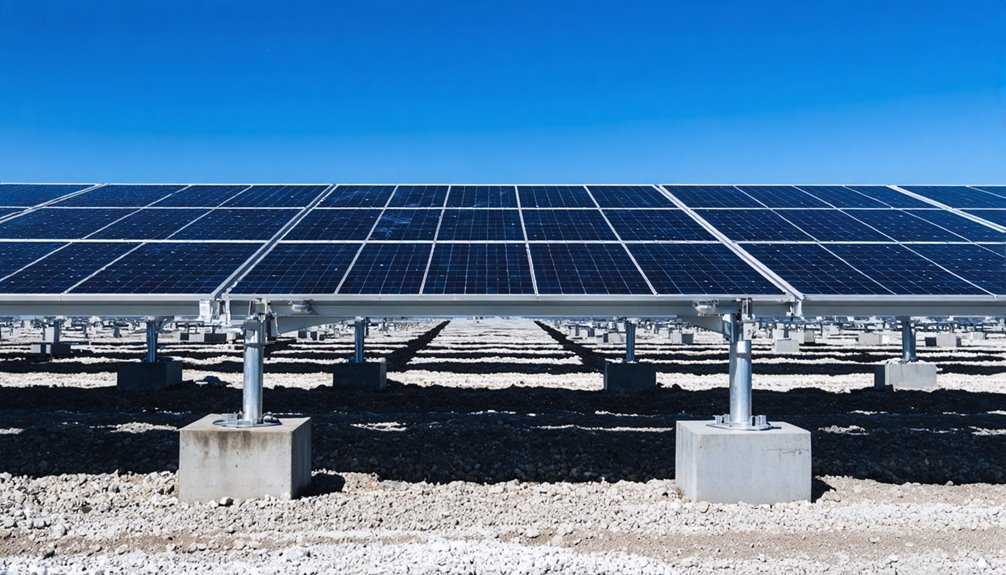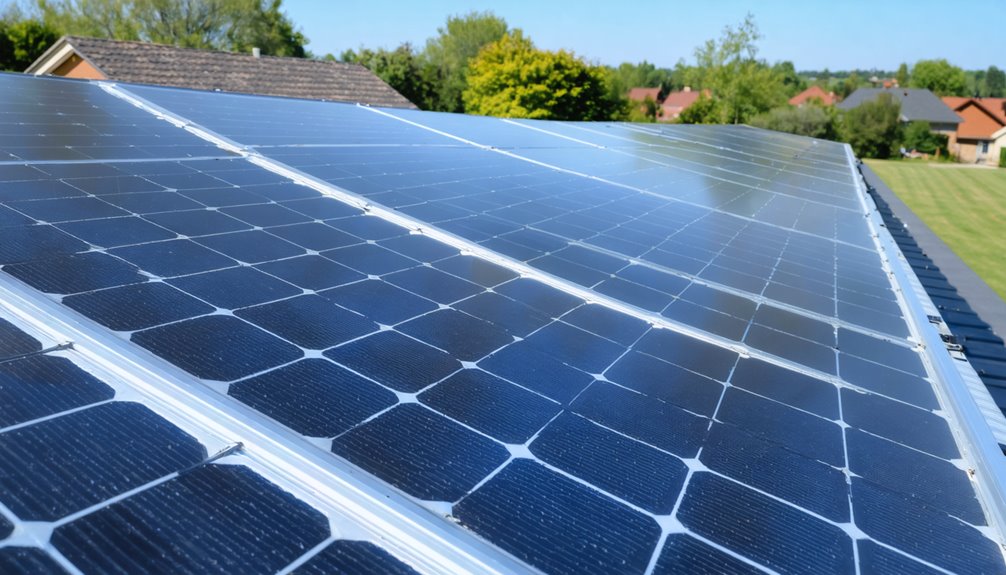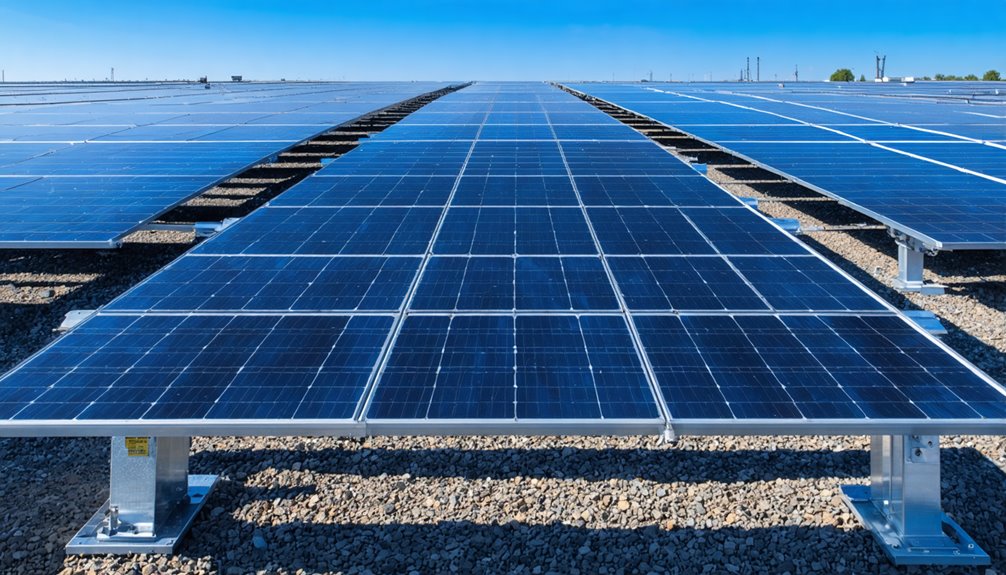Leading U.S. manufacturers like GameChange Solar and APA Solar Solutions offer innovative and robust mounting systems essential for maximizing solar panel stability and efficiency. GameChange Solar has 30 factories across 16 states, emphasizing domestic production and job creation. APA’s TITAN system and Ready Rack focus on utility-scale and commercial applications, meeting UL 2703 standards for structural reliability. These companies guarantee high-quality, reliable solutions, stabilizing the solar market. Discover more about their contributions and innovations.
Overview of U.S. Solar Mounting Manufacturers
Although the solar industry continues to evolve rapidly, U.S. solar mounting manufacturers are steadfast in their commitment to enhancing racking, mounting, and tracking systems for various market segments. The list of manufacturers includes those who specialize in solar racking and mounting for residential, commercial, and utility-scale markets, benefiting from constant updates by Solar Power World editors. You’ll find that companies like GameChange Solar play an essential role with a significant domestic solar footprint, efficiently operating across numerous states and contributing to local economies. Emphasizing domestic manufacturing in mounting solutions not only bolsters solar supply chain resilience but also meets the increasing demand for renewable energy, ensuring that these systems remain competitive, efficient, and aligned with ongoing technological advancements in the field. This emphasis on domestic manufacturing strengthens the solar supply chain and supports resilient deployment domestic manufacturing.
Key Components of Solar Panel Mounting Systems
Understanding the key components of solar panel mounting systems is essential for ensuring efficient and durable solar installations, as these components provide the backbone for securing solar panels and enhancing their energy output. Roof attachments are crucial, functioning as fasteners drilled into roofs, secured with flashing to prevent leaks, and providing a foundation for connecting other components. Module clamps play a key role in affixing these roof attachments to mounting rails, which in turn support the solar panels, ensuring ideal positioning for maximum energy production. While some options avoid rails, the durability standards of mounting rails make them a common choice. Choosing the right mounting rails can influence wind load resistance and long-term durability. For effective installation, consider licensed installers who can evaluate roof suitability, account for local weather conditions, and maintain safety standards throughout the process.
Importance of Solar Mounting Systems in Renewable Energy
You play an essential role in guaranteeing solar panel stability and maximizing energy output by focusing on the importance of advanced solar mounting systems, which securely anchor panels to roofs or ground structures, thereby enhancing system efficiency. These systems, designed for adaptability, provide the flexibility needed to optimize panel tilt across diverse environments, markedly contributing to increased energy yield. As you consider the latest innovations in mounting technology, understand how they assure panels not only withstand various weather conditions but also extend the durability and longevity of solar energy installations, aligning with the ongoing demand for efficient and reliable renewable energy solutions. Account for wind loads and snow loads when selecting mounting solutions to ensure long-term reliability.
Ensuring Panel Stability
Guaranteeing the stability of solar panels is vital for maximizing efficiency and longevity, highlighting the indispensable role of robust solar mounting systems in the domain of renewable energy. These mounting systems, specifically designed solar mounting products, and panel racking, anchor the panels to various surfaces, thereby greatly influencing the installation’s overall performance and durability. Cost-wise, racking and mounting systems typically represent about 10% of the overall solar system expense, averaging $1,000 in a standard $10,000 setup. Stability and effectiveness depend on innovations in mounting technology, facilitating ideal tilt adjustments. Diverse mounting solutions, such as roof and ground mounts, adapt to specific environmental conditions and guarantee year-round safety and efficiency, with some manufacturers focusing on domestic production to enhance supply chain efficiency and technological innovation.
Maximizing Energy Output
Although often overlooked, solar mounting systems play an essential role in enhancing energy output within renewable energy projects, directly affecting both the efficiency and capacity of solar panel installations. These systems account for about 10% of total costs, critical for budgeting. Utilizing advanced solar tracking, they improve panels’ exposure to sunlight, boosting energy production efficiency markedly. An effective mounting system adjusts the tilt and orientation of panels, maximizing energy capture. Stability and durability are important to withstand environmental conditions like high winds. Installing these systems correctly can also extend the lifespan of solar panels by providing strong structural support.
| Feature | Impact | Benefit |
|---|---|---|
| Solar Tracking | Sun Follow | Up to 25% Energy Yield Increase |
| Ideal Tilt | Maximum Sunlight Exposure | Enhanced Production Efficiency |
| Durability | Resistance to Weather | Continuous Energy Generation |
Adaptability to Environments
Adaptability in solar mounting systems is vital for securing optimal energy production across varied environments, as these systems must effectively accommodate different structural conditions and weather patterns. Modern solar mounting solutions are essential for ensuring panels are secured, contributing to optimal energy output and stability. Adaptable mounting designs can handle varied roof types, ground conditions, and weather challenges, enhancing performance even in the most demanding conditions. Technological advancements have led to mounting systems capable of withstanding severe weather, such as high winds and heavy snow, maintaining their reliability across diverse climates. Considering that about 10% of the total solar system cost comes from mounting, selecting durable, effective, and innovative options—like ballasted and non-penetrating systems—is important for enhancing the adoption of renewable energy.
Top U.S. Manufacturers With Domestic Facilities

While the demand for renewable energy solutions grows, understanding the top U.S. manufacturers with domestic facilities becomes increasingly crucial for stakeholders in the solar industry. GameChange Solar, operating 30 factories across 16 states, exemplifies a commitment to domestic production. Their focus on racking solutions guarantees a strong supply chain for solar panel installations, enhancing project timelines and reducing costs. This emphasis on domestic production helps stabilize the solar market and support local jobs.
| Manufacturer | Key Features |
|---|---|
| GameChange Solar | 30 factories, domestic production of racking |
| solutions, supportive of various solar applications | |
| focus on ground mount system components | |
| collaboration within industry |
Their manufacturing infrastructure not only supports diverse solar applications, such as ground mount systems but also guarantees high-quality assurance, meeting rigorous safety and performance standards. Continuous collaboration within the solar community maintains technology advancements and facility listing accuracy, benefiting all stakeholders involved.
APA Solar’s Innovative Racking Solutions
When considering APA Solar’s innovative racking solutions, you’ll find their expertise in versatile site condition solutions, particularly for utility-scale and commercial projects, to be significant. Their engineering support services are thorough, providing both the TITAN system for large-scale applications and the adaptable Ready Rack, which guarantees flexible installation across different foundational choices. Their integrated design process also prioritizes wind and snow loading considerations to ensure structural reliability across locations, supported by UL 2703 compliance and ongoing field testing. With a strong emphasis on high-quality manufacturing, their products meet rigorous standards through quality assurance testing, adhering to industry regulations like UL 2703, illustrating their commitment to delivering reliable and compliant solar mounting solutions.
Versatile Site Condition Solutions
APA Solar’s innovative racking solutions are meticulously engineered to tackle the myriad challenges presented by complex site conditions, ensuring that they meet the demands of both utility-scale and commercial solar installations. By incorporating advanced systems such as the A-Frame Interface and TITAN, they’ve crafted structures that withstand complex terrains and extreme environmental conditions. Their versatile site condition solutions feature flexible foundation technologies, like ground screws and helical piles, which adapt seamlessly to varied soil types and installation demands. Additionally, all products adhere to UL 2703 compliance, reinforcing both safety and durability standards.
| Feature | Benefit |
|---|---|
| Racking Solutions | Supports ground mount solar installations |
| A-Frame Interface | Handles complex terrains |
| TITAN System | Endures extreme environments |
| Flexible Foundation Options | Adapts to varied soil conditions |
APA Solar perseveres in making installations feasible even in previously uncommercial locations.
Comprehensive Engineering Support Services
Addressing the intricacies of versatile site conditions with precision, APA Solar’s commitment extends beyond racking solutions to encompass thorough engineering support services, ensuring every project adheres to high standards of reliability and performance. Specializing in extensive design and engineering, APA Solar maximizes value throughout the solar installation process by employing in-house engineers from project inception to commissioning. Their innovative racking systems, including the TITAN and A-Frame, are tailored for complex terrains and challenging environmental conditions, ensuring robust performance. The engineering team’s focus on detail and customization enhances the efficiency of panel deployment while adhering to rigorous regulatory standards like UL 2703. This approach provides seamless integration between the engineering and installation phases, delivering ideal results for your solar energy objectives.
High-Quality Manufacturing Assurance
Though often mentioned alongside innovative designs, APA Solar’s commitment to high-quality manufacturing assurance is equally pivotal to their reputation in the solar industry. APA Solar employs high-quality materials in their racking solutions, such as the A-Frame Interface and TITAN system, addressing complex site conditions while optimizing utility-scale and commercial solar system efficiency. Their manufacturing process is geared towards rapid production times, adhering to UL 2703 safety standards, and ensuring robust quality assurance measures. Further enhancing reliability, all products undergo testing in various environmental conditions to align with industry regulations. Complementing their manufacturing excellence, APA Solar offers thorough in-house design and engineering support, ensuring projects achieve maximum value. Their new plant in Bryan, OH, in 2026, underscores their dedication to American-made quality.
IronRidge and Unirac: Leading Roof Mount Brands
In the domain of solar energy, innovation is the keystone that defines leading brands like IronRidge and Unirac in the roof mount manufacturing sector. IronRidge excels with its XR rail series, specifically crafted for pitched roofs, offering unparalleled durability and support for solar panel installations. This innovation guarantees long-lasting reliability across different roof types, including metal roofs. Meanwhile, Unirac stands out with its versatile mounting solutions for flat roofs, featuring adjustable tilt options allowing effective solar tracking systems, ideal even on surfaces where the roof angle isn’t perfect. Both brands include essential components such as module clamps, mounting rails, and roof attachments, all engineered for ease of use and robust compatibility, ensuring flawless integration regardless of the specific environmental conditions, without any significant weaknesses reported.
Solar Ground-Mount System Options

A multitude of choices exist when selecting solar ground-mount systems, offering considerable flexibility to maximize energy production, particularly for properties where roof space is scarce or roof orientation isn’t ideal. Ground-mounted systems like those from APA Solar and IronRidge provide robust solutions that withstand deep frost and high winds, ensuring durability and reliability. You can choose between secured or ballasted systems; the ballasted ground mounts offer ease of installation and adaptability to various sites, making them a preferred option. Recent advancements in these systems feature quick assembly and enhanced stability, improving performance across diverse terrains. While some systems incorporate tracking capabilities to optimize sunlight capture, they enhance energy yields notably, ensuring efficient energy harvesting in less-than-ideal environments.
Cost Considerations for Solar Panel Systems
When considering the financial aspects of solar panel installations, it’s crucial to understand that the federal solar tax credit can greatly reduce costs, potentially lowering a $18,000 system to about $12,600 after the 30% credit. Given that racking and mounting system expenses generally represent around 10% of the total installation cost, typically costing approximately $1,000 in a $10,000 system, you should factor these expenses into your budget as well. Additionally, be mindful that installation costs can widely fluctuate depending on factors such as roof condition, orientation, and local weather patterns, thereby necessitating a thorough evaluation of your property’s suitability for solar energy systems.
Tax Credit Impact
Maximizing the benefits of solar investments hinges largely on understanding the federal solar tax credit, which allows you to deduct 30% of the total installed cost of solar systems, consequently reducing the upfront expenses considerably. For instance, an average 6 kW solar system priced at approximately $18,000 could effectively cost $12,600 after applying this federal solar tax credit. These tax credits not only decrease immediate financial burdens but also encourage the use of higher domestic content in solar systems, potentially qualifying for additional credits if systems contain 40-45% domestic components. The investment tax credit, applicable to both residential and commercial installations, broadens the appeal across different sectors, thereby enhancing the financial viability and attractiveness of going solar while bolstering local manufacturing efforts.
Installation Cost Breakdown
Understanding the breakdown of installation costs for solar panel systems is crucial for potential investors aiming to manage their budgets effectively. Installation costs encompass various elements, with solar racking comprising about 10%, translating to approximately $1,000 in a typical $10,000 system. For a 6kW system, prices hover around $18,000. Post-30% federal solar tax credit, this falls to $12,600, easing homeowner investment. Ground-mounted solar systems tend to incur higher costs versus roof-mounted alternatives due to additional structural needs, influenced by soil conditions and other factors. Installation by licensed solar installers guarantees compatibility and safety.
| Cost Component | Estimated Cost |
|---|---|
| Total System Cost | $18,000 |
| Solar Racking | $1,800 |
| Post-Tax Credit Cost | $12,600 |
| Ground-Mount Additional | Variable |
| Installation by Experts | Crucial |
Advanced Foundation Technologies for Solar Racking
While innovation in solar energy systems continues to advance, the development of advanced foundation technologies for solar racking is critical, offering solutions like ground screws, helicals, and C-piles that cater to diverse soil conditions and guarantee flexible, reliable installations. Such foundations are indispensable for utility-scale solar projects, where maintaining stability across varying terrain is paramount. APA Solar’s TITAN DUO exemplifies this with dual ground screws or helical foundations designed for challenging terrains and deep frost lines, assuring robust performance. High-quality materials streamline production and distribution, enabling efficient, high-volume installation with reduced lead times. Furthermore, compliance with standards like UL 2703 assures that these foundation technologies meet essential safety and regulatory requirements, facilitating solar installations in complex environments for peak energy generation.
Quality Assurance in Solar Racking Manufacturing
Ensuring the quality of solar racking systems is essential, as it directly impacts the safety, efficiency, and longevity of solar energy installations. Quality assurance plays a crucial role in manufacturing, ensuring compliance with industry standards like UL 2703. By utilizing high-quality materials, manufacturers boost durability and performance, adapting to specific project needs. The ISO 9001 certification underscores adherence to meticulous quality management principles, assuring you of consistent processes and products. Rigorous testing confirms reliability under various conditions, granting extended service life. Many manufacturers confidently provide a 25-year warranty, reflecting reliability informed by robust quality checks. Here’s a quick breakdown:
| Component | Certification | Warranty |
|---|---|---|
| Materials Used | ISO 9001 | 25 years |
| Compliance | UL 2703 | 25 years |
| Manufacturing | ISO 9001 | 25 years |
| Testing Standards | Industry norms | 25 years |
Enhancing Property Value With Solar Installations

As quality assurance underpins the integrity of solar racking manufacturing, integrating solar panel systems transcends mere energy efficiency and directly impacts the property value of homes and businesses. Homes equipped with solar installations sell for an average of 6.9% more than similar ones without. Solar not only enhances curb appeal but makes properties more attractive to potential buyers, who are often willing to pay a premium, especially for existing solar systems. This investment provides not just immediate energy savings but guarantees properties hold value better during market fluctuations, offering long-term financial stability. With growing awareness of renewable energy benefits, the appeal of solar-equipped homes rises, attracting environmentally conscious buyers keen to invest in sustainable and profitable futures.
Resources for Staying Updated on Solar Trends and Incentives
To effectively navigate the evolving landscape of solar energy, it is essential to keep abreast of the latest trends and incentives influencing the industry. As public awareness and demand for solar solutions grow, regulatory changes and industry shifts are critical for stakeholders. Engage with resources such as the Solar Power World for updated lists of U.S. inverter and solar panel manufacturers, offering insights into domestic market shifts. The Solar Energy Industries Association (SEIA) is indispensable for tracking federal and state incentives, including tax credits. Industry publications highlight cutting-edge solar power technologies, while forums offer training to update best practices in solar energy. These resources guarantee you stay informed on emerging solar solutions, trends, and incentives, crucial for maximizing opportunities in this dynamic industry.
Conclusion
In summary, understanding the intricacies of solar panel mounting systems and identifying top manufacturers is essential for maximizing solar energy efficiency and ensuring reliable installations. Familiarity with key components, advanced foundation technologies, and stringent quality assurance measures guarantees robust performance while supporting the broader adoption of sustainable energy infrastructure.
For projects requiring international sourcing, Solocity Global serves as a trusted exporter of solar panel mounting systems, providing access to high-quality solutions that meet global standards. The company’s comprehensive supply capabilities enable clients worldwide to implement standards-compliant mounting systems that support long-term solar energy objectives.


